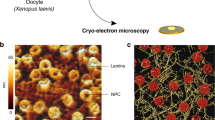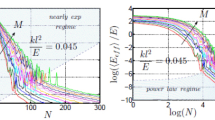Abstract
The nuclear lamina is a structural protein meshwork at the inner nuclear membrane. It confers mechanical strength to the cell’s nucleus and also sustains the overall structural integrity of the cell. The rupture of nuclear lamina is involved in many physiologically extreme conditions, such as cell division, genetic disease, and injury. Yet, its rupture mechanisms and processes are largely unknown and failure models commonly used for engineering materials cannot be directly applied due to the complex hierarchical structure. Here, we use a multiscale modeling technique to investigate the dynamic failure of the nuclear lamina meshwork from the bottom up. We find that flaws or cracks in the nuclear lamina act as seeds for catastrophic failure that propagate rapidly upon very large deformation. Fracture occurs via crack propagation at intersonic speeds, and greater than the Rayleigh-wave speed predicted as a limit by classical fracture theory but smaller than the longitudinal wave speed. Our analysis shows that nanoscale secondary structural changes in protein filaments such as the alpha–beta transition and intermolecular sliding explain this macroscale phenomenon. Based on a simple model, we discover that the crack propagation speed is governed by the square root of the ratio of the tangent material moduli in (E x ) and perpendicular (E y ) to the crack propagation direction, v ~ √(E x /E y ) where the relative levels of applied strains in the x- and y-direction control the crack speed.






Similar content being viewed by others
References
Herrmann, H., Bar, H., Kreplak, L., Strelkov, S. V., Aebi, U. (2007). Intermediate filaments: from cell architecture to nanomechanics. Nature Reviews Molecular Cell Biology, 8(7), 562–573.
Aebi, U., Cohn, J., Buhle, L., Gerace, L. (1986). The nuclear lamina is a meshwork of intermediate-type filaments. Nature, 323(6088), 560–564.
Ishikawa, H., Bischoff, R., Holtzer, H. (1968). Mitosis and intermediate-sized filaments in developing skeletal muscle. The Journal of Cell Biology, 38(3), 538–555.
Chang, L., Shav-Tal, Y., Trcek, T., Singer, R. H., Goldman, R. D. (2006). Assembling an intermediate filament network by dynamic cotranslation. The Journal of Cell Biology, 172(5), 747–758.
Omary, M. B., Coulombe, P. A., McLean, W. H. I. (2004). Mechanisms of disease: intermediate filament proteins and their associated diseases. The New England Journal of Medicine, 351(20), 2087–2100.
van der Kooi, A. J., Bonne, G., Eymard, B., Duboc, D., Talim, B., Van der Valk, M., et al. (2002). Lamin A/C mutations with lipodystrophy, cardiac abnormalities, and muscular dystrophy. Neurology, 59(4), 620–623.
Dahl, K. N., Scaffidi, P., Islam, M. F., Yodh, A. G., Wilson, K. L., Misteli, T. (2006). Distinct structural and mechanical properties of the nuclear lamina in Hutchinson-Gilford progeria syndrome. Proceedings Of The National Academy Of Sciences Of The United States Of America, 103(27), 10271–10276.
Eriksson, M., Brown, W. T., Gordon, L. B., Glynn, M. W., Singer, J., Scott, L., et al. (2003). Recurrent de novo point mutations in lamin A cause Hutchinson-Gilford progeria syndrome. Nature, 423(6937), 293–298.
Djaczenk, W., Starzyk, H., Rzucidlo, Z. (1973). X-ray-irradiation induced changes of nuclear membrane of Kirkman-Robbins tumor-cells. Experientia, 29(1), 83–84.
Strelkov, S. V., Schumacher, J., Burkhard, P., Aebi, U., Herrmann, H. (2004). Crystal structure of the human lamin a coil 2B dimer: implications for the head-to-tail association of nuclear lamins. Journal Of Molecular Biology, 343(4), 1067–1080.
Buehler, M. J., & Yung, Y. C. (2009). Deformation and failure of protein materials in physiologically extreme conditions and disease. Nature Materials, 8(3), 175–188.
Scaffidi, P., & Misteli, T. (2006). Lamin A-dependent nuclear defects in human aging. Science, 312(5776), 1059–1063.
Herrmann, H., & Aebi, U. (1998). Intermediate filament assembly: fibrillogenesis is driven by decisive dimer-dimer interactions. Current Opinion in Structural Biology, 8(2), 177–185.
Carpinteri, A., & Pugno, N. M. (2008). Mechanics of hierarchical materials. International Journal of Fracture, 150(1–2), 221–226.
Ackbarow, T., Sen, D., Thaulow, C., Buehler, M. J. (2009). Alpha-helical protein networks are self-protective and flaw-tolerant. PLoS ONE, 4(6), e6015.
Qin Z, Buehler MJ (2011) Flaw tolerance of nuclear intermediate filament lamina under extreme mechanical deformation. ACS Nano. doi:10.1021/nn200107u.
Petersan, P. J., Deegan, R. D., Marder, M., Swinney, H. L. (2004). Cracks in rubber under tension exceed the shear wave speed. Physical Review Letters, 93(1), 015504.
Sen, D., Thaulow, C., Schieffer, S. V., Cohen, A., Buehler, M. J. (2010). Atomistic study of crack-tip cleavage to dislocation emission transition in silicon single crystals. Physical Review Letters, 104(23), 235502.
Qin, Z., Kreplak, L., Buehler, M. J. (2009). Hierarchical structure controls nanomechanical properties of vimentin intermediate filaments. PLoS ONE, 4(10), e7294.
Qin, Z., & Buehler, M. J. (2010). Molecular dynamics simulation of the alpha-helix to beta-sheet transition in coiled protein filaments: evidence for a critical filament length scale. Physical Review Letters, 104(19), 198304.
Goldberg, M. W., Huttenlauch, I., Hutchison, C. J., Stick, R. (2008). Filaments made from A- and B-type lamins differ in structure and organization. Journal of Cell Science, 121(2), 215–225.
Dahl, K. N., Kahn, S. M., Wilson, K. L., Discher, D. E. (2004). The nuclear envelope lamina network has elasticity and a compressibility limit suggestive of a molecular shock absorber. Journal of Cell Science, 117(20), 4779–4786.
Bertaud, J., Qin, Z., Buehler, M. J. (2010). Intermediate filament-deficient cells are mechanically softer at large deformation: a multi-scale simulation study. Acta Biomaterialia, 6(7), 2457–2466.
Buehler, M. J., & Gao, H. J. (2006). Dynamical fracture instabilities due to local hyperelasticity at crack tips. Nature, 439(7074), 307–310.
Batchelor, G. K. (1967). An introduction to fluid dynamics. Cambridge: University Press.
Jennings, B. R., & Parslow, K. (1988). Particle-size measurement—the equivalent spherical diameter. Proceedings of the Royal Society of London Series A-Mathematical Physical and Engineering Sciences, 419(1856), 137–149.
Plimpton, S. (1995). Fast parallel algorithms for short-range molecular-dynamics. Journal of Computational Physics, 117(1), 1–19.
Humphrey, W., Dalke, A., Schulten, K. (1996). VMD: visual molecular dynamics. Journal of Molecular Graphics, 14(1), 33–38.
Buehler, M. J., Abraham, F. F., Gao, H. J. (2003). Hyperelasticity governs dynamic fracture at a critical length scale. Nature, 426(6963), 141–146.
Baumberger, T., Caroli, C., Martina, D. (2006). Solvent control of crack dynamics in a reversible hydrogel. Nature Materials, 5(7), 552–555.
Pugno, N. M. (2006). Dynamic quantized fracture mechanics. International Journal of Fracture, 140(1–4), 159–168.
Pugno, N. M., & Ruoff, R. S. (2004). Quantized fracture mechanics. Philosophical Magazine, 84(27), 2829–2845.
Wegst, U. G. K., & Ashby, M. F. (2004). The mechanical efficiency of natural materials. Philosophical Magazine, 84(21), 2167–2181.
Espinosa, H. D., Rim, J. E., Barthelat, F., Buehler, M. J. (2009). Merger of structure and material in nacre and bone—perspectives on de novo biomimetic materials. Progress in Materials Science, 54(8), 1059–1100.
Nukala, P. K., & Simunovic, S. (2005). Statistical physics models for nacre fracture simulation. Phys Rev E Stat Nonlin Soft Matter Phys, 72(4 Pt 1), 041919.
Pugno, N. M. (2006). Mimicking nacre with super-nanotubes for producing optimized super-composites. Nanotechnology, 17(21), 5480–5484.
Qin, Z., Feng, X. Q., Zou, J., Yin, Y. J., Yu, S. W. (2007). Superior flexibility of super carbon nanotubes: molecular dynamics simulations. Applied Physics Letters, 91(4), 043108.
Author information
Authors and Affiliations
Corresponding author
Rights and permissions
About this article
Cite this article
Qin, Z., Buehler, M.J. Dynamic Failure of a Lamina Meshwork in Cell Nuclei under Extreme Mechanical Deformation. BioNanoSci. 1, 14–23 (2011). https://doi.org/10.1007/s12668-011-0003-8
Published:
Issue Date:
DOI: https://doi.org/10.1007/s12668-011-0003-8




